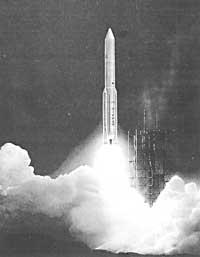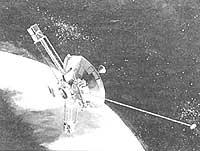Final limit of the solar system
1987/08/01 Etxeberria, E. Iturria: Elhuyar aldizkaria
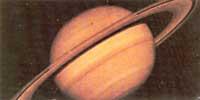
But Pioneer 10 does not work only on interstellar flights. It has joined three other vessels already directed towards the stars (Pioneer 11, Voyager 1 and Voyager 2). They are old vehicles; chopos and not equipped for long trips. However, they will be the first boats to leave the solar system.
These four spacecraft offer us a poor version of man about interstellar travel. The next step in the advancement of space flights will be a much larger and more expensive proposition: to send man to the stars. But the basic questions are: Can high-speed interstellar travel be achieved for humans? What are the consequences? What technological and physical barriers will have to be overcome? To answer these questions, it is essential to immerse ourselves in the framework of scientific facts and science fiction.
Towards the heliopause
Pioneer 10, the first probe sent to Jupiter, was launched in March 1972. Twenty months later, the ship sent a lot of data to 131,000 kilometers of the giant planet. Pioneer 10 continued its flight out of the solar system through the orbit of Neptune (4.5 billion kilometers from the sun) on that historic day of June 1983.
Pioneer 10's twin, Pioner 11, came out in April 1973 and in December 1974 reached Jupiter. Following a different path, Pioneer 11 passed 43,000 kilometers from the highest mists of Jupiter and received the gravitational support of the giant planet, directing the boat to Saturn.
The two Voyager boats were subsequently launched (Voyager 2 in August 1977 and Voyager 1 in September 1977). These two vessels entered the gravity zone of Jupiter and, increasing the speed, continued towards Saturn. Voyager 1 ended his journey here and Voyager 2, in 1989, is ready to reach Neptune.
As the first spectator of the mysterious gas giants, these four robots could not be more successful.
First, we must differentiate the interplanetary space from interstellar space. Does the boundary of interstellar space mark the final gravitational effect of the Sun?
Recent computer simulations show that the sun is able to attract objects located at 80,000 or 100,000 astronomical units or 0.5 parsec. This distance is one third of the vial that lies at the nearest star.
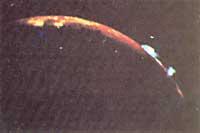
Gravity is a force that gradually decreases and never ends. A more significant definition of the exact boundary of the Solar System can be obtained by analyzing the behavior of the solar wind, that is, the emission of charged particles from the sun.
In the starry, at a point in space, the gas pressure must cause the stagnation of this solar wind. Consequently, there must be an area (helios) that is balanced when the particles of the solar wind collide against the interstellar gas. In theory, this shock will emit low-frequency radio waves that can be detected by the Pioneer and Voyager spacecraft.
The heliopause would not be fully circular, as the interstellar gases flowing around it would form pears. The Pioneer 10 probe runs through the frost tail and may not reach its limit before its energy supply ends by 1995. At this time it is dedicated to approximately 37 astronomical units and the data it sends indicate whether the heliopause is at 65 astronomical units of the sun.
But the message coming from Voyager is different. Weak radio signals from the helium zone have already begun to be received, reaching up to 2-3 kilohertz. These signals may have a completely different origin, such as a galactic radio source that has never been found so far. But as the Voyager ships move away, the signals are reinforced and if the reason is a heliopause, that is what we would expect.
Considering that the density of the solar wind decreases uniformly with the distance, Voyager signals indicate that the heliopause is located at 46 astronomical units (direction to which the Voyagers go) of the sun. If this analysis is correct, the ship that will reach the limit of the helium and cross the interstellar space will not be the farthest, the Pioneer 10. It is a Voyager 1 probe, which for more than six years has been rising forming a sharp angle outside the plane of the solar system.
Finding a heliopause would be a breakthrough, but will any of these spacecraft last so long without stopping? The answer depends on the thermoelectric generators by means of radioisotopes of the boats. Favoring the disintegration of Plutonium-238, Pioneer generators are expected to remain until mid-1990 and Voyager generators until 2012-2019. By 2012 the two Voyagers will have 100 astronomical units surpassed and will probably have a crossed heliopause.
Where does all this take us?
The first spacecraft directed at human stars are nothing more than escaped interplanetary probes. So how much do we need for the first time to build a true interstellar ship? The interstellar journey is not only an extension of the interplanetary journey. This type of elaborate scientific mission presents qualitative differences with respect to that carried out to date. The reason is the amplitude of interstellar space.
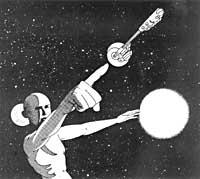
The red dwarf Proxima Centauri is 1.3 parsec (40 trillion kilometres) and is part of the Alpha Centauri triple star system. Alpha Centauri A itself is a sun-shaped star with the Alpha Centauri B (somewhat weaker, colder and larger than the Alpha Centauri) nearby.
Within four parsec we have two dozen more stars, most of them red dwarfs. The brightest star is Sirius A; a red and white star, accompanied by a white dwarf named Siruis B. In addition to the Sirius stars, within the radius of 4 parsec we have two other stars: Procyon A and Alpha Centauri A, brighter than the sun.
However, in our small corner of the galaxy there are a lot of interesting stars: red dwarfs and txuris, gastric, double and triple stars, class G, class F, and class A stars, class A stars, that subinane similar to cooking and some oranges and planetary friends. Other stars that are the last event. This last milestone is very important, because once in the interstellar space, probably one of our goals is to look for new worlds and civilizations, not only know the stars better.
But again we find the old problem of distance. The highest speed achieved to date by a spacecraft is 51,800 kilometers per hour, the case of the Pioneer 10. This would be fine to go to nearby planets but not for interstellar journeys. With a final displacement speed of about 40,000 kilometers per hour, the Pioneer 10 will take more than 78,000 years to travel a simple parsec!
With the help of gravity that a large planet like Jupiter can have using conventional chemical rockets, we can easily foresee that the speed is ten times faster. However, going to the nearest star takes more than 10,000 years. What is clear is that suitable speeds to the solar system are not valid for interstellar travel. We need a whole new form of propulsion.
Daedalus Project
The Daedalus project is unique: A red dwarf to Bernard's star in parsec -1.8 is intended to reach a generation, explore the star system and send information to Earth.
The propulsion capacity of the Daedalus Navy necessary to carry out this project is possible thanks to a process already known in the Ministers of Defense of the Earth, nuclear fusion. But the difficulty is: Daedalus will operate using the fusion of deuterium and helium-3. The second, the isotope of helium, is very rare on our planet. The collection of the 30,000 tons needed to power Daedalus requires the use of a richer source, located about 800 million kilometers from the cold, strange and terrible surface of Jupiter.
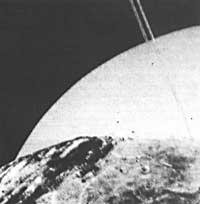
After twenty years of effort and the most complex engineering project ever made, Daedalus addresses Jupiter to supply fuel. Thus begins the project of Bernard towards Izar.
The main motor will turn on. From now on it will fire two hundred and fifty times per second and a pill with helium-3 ice cream to the giant loft that carries the boat in the back. Each of these pills will encounter the high velocity electrons of closed discharge, which are able to produce fusion reactions between deuterium and helium-3. The explosion of several tons of TNT will cause fusion products to come out forcefully from the engine chamber and give a tremendous boost to Daedalus.
The engines will not stop after a few minutes of effort, but will remain in operation for more than two years, accelerating the ship up to 7 percent of the light speed (or 21,000 kilometers per second). Then the first heavy platform of the Daedalus falls and the second is launched. The vessel will reach a speed of up to twelve percent of the speed of light in the next twenty months. Finally, the second platform collapses and Daedalus will continue to travel 36,000 kilometers per second for 47 more years. At the end of this season the boat will arrive at the Star of Bernard and will enter the most important phase of its journey.
Stretching the telescopes it carries over and sending robot probes over the interesting worlds it finds, Daedalus will collect rich data about Bernard's Star System. The data that can be collected by humans will be analyzed using a computer programmed with foresight and artificial intelligence. Still in the eighth part of the speed of light, it will send to Earth its processed and elaborate analyses. About sixty years after the takeoff of its main engine, ground travel controllers (or their children and grandchildren, or rather) will be able to see what Daedalus discovered.
All this, of course, will not be exactly like that. The Daedalus project is only a design; XX. Only a vision of the interstellar journeys of the future since the twentieth century. The value of this plan is to see that it is possible to fly to the stars using what is not so far from current technology. To begin with, to trips to the nearest stars, which will last less than human life, we can ship robot boats.

Gai honi buruzko eduki gehiago
Elhuyarrek garatutako teknologia




